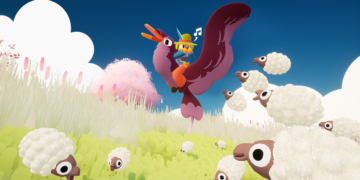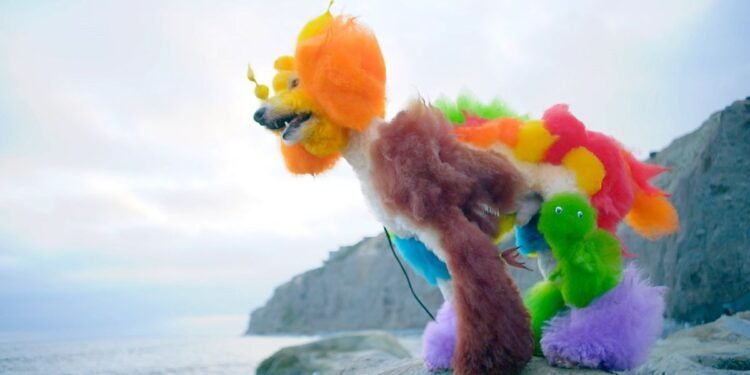The average viewer is not going to go into the documentary Well Groomed expecting any profound revelations about the world of competitive dog grooming, where owners dye their animals in neon colors and sculpt their fur into elaborate, fanciful designs. Most of the people who’d sit down for such an odd little niche film will probably just be looking for the real-life equivalent of Christopher Guest’s mockumentary Best in Show — a funny, light film about the wacky personalities in an extremely tiny, extremely specific dog-centric subculture.
And that’s exactly what they’re going to get. Rebecca Stern’s documentary (dogumentary?) doesn’t offer much context about what most of the film’s participants just shorthand as “Creative.” (As in “Creative isn’t for everyone. It has to be in your blood.”) There’s no big history of Creative dog grooming, no top-down look at the big competitions where it’s a tiny sidebar, no insights into some of the field’s more immediately noticeable quirks. Well Groomed only briefly touches on the inevitable controversies around the field.
The doc never feels propulsive, or even particularly informative, and it never has to. For people who remotely enjoy the existence of dogs, Well Groomed is one of the most wholesome, joyous, purely enjoyable documentaries in the streaming world, and Stern doesn’t aspire to anything more.

Photo: Cattle Rat Productions
Stern starts out by introducing a few figures from the Creative circuit, including young New York up-and-comer Nicole Beckman, Creative legend Angela Kumpe, and South Carolina veteran Adriane Pope, who’s gunning for her first championship. It’s immediately noticeable that all Stern’s interviewees are women. Seemingly all the competitors seen onstage during the film’s various Creative grooming competitions are women as well. Even the audiences at the expos where the competitions take place skew heavily female. It’s as though the entire subculture is dominated by women. This may be one of the first documentaries where virtually every scene featuring more than one speaker immediately passes the Bechdel Test.
The gender leaning of the hobby is one of the many things Stern doesn’t interrogate. She also doesn’t do much to explore the fact that the Creative-circuit competitors are generally professional dog-groomers who are also attending these shows so their other dogs can compete in standard breed categories. A lot is implied but not said in this light 87-minute film, and the lack of context can be frustrating. Watching the movie’s trailer, viewers may ask, “Why would people do this to dogs? What do owners get out of this hobby?” They’re likely to come out of the movie with those questions answered, and many, many more questions in their place.
Stern lets her subjects tell their stories in their own words, which amount to bland, simple aphorisms: Creative dog-grooming is fun, it’s an outlet for bored groomers who want to express themselves, it’s satisfying to play with color. The observations don’t get sharper than that, except when Kumpe takes her turn in front of the camera. Of all the Creative stylists profiled, she’s the sharpest and funniest, and the most expressive. She talks frankly about people’s rage over her hobby: “Creative groomers get all the crazies,” she chuckles. “We should be ashamed of ourselves for those poor animals. How embarrassed they must be, we should all go die. We get death threats and stuff. And I just start sending them lots of pictures of colorful dogs.”

Photo: Cattle Rat Productions
But mostly, Stern just watches as the groomers play with and cuddle their brightly painted animals, weep over a cancer-stricken canine taking its last trip to the vet, or take their pets on walks or dog-park runs, where people stop, stare, and take pictures. The film emphasizes how normal these dogs’ lives are, how beloved they are, and how readily they cooperate with the grooming techniques. For every slower aside, like Nicole pondering how to redecorate the dog salon she’s just taken over, or Adriane attending a tiny Southern church, there’s a scene of dogs bounding over each other in a yard, or enthusiastically licking an owner’s face. The households where these dogs live are the kind of places decorated with bumper-sticker slogans like “Dogs are like potato chips, you can’t have just one,” and “We’re staying together for the sake of the dogs.”
All the low-key, affectionate interactions between owners and pets are warming, and they make a mid-film interlude seem even more ridiculous, as a series of talk-show hosts decry Creative dog-grooming as humiliating and unnatural for dogs. There certainly are questions about the hobby — about whether the dyes are dangerous, about inbreeding in show dogs and purebreds in general — but Stern limits herself to depicting the outside world’s concerns as parochial, scoldy, and busybody-ish.
Instead, she focuses on the craft itself, with plenty of warm closeups of fluffed-up poodle hair in jewel-tone patterns being brushed or trimmed, and rows of dogs onstage at conventions being hairsprayed, airbrushed, and bedazzled until their pelts look like Smurfs or dinosaurs or safari animals. Stick-on googly eyes and embedded LEDs abound, along with prop hats, beaks, and toys. At the world’s biggest dog-grooming competition, entrants build corny little skits around their dog presentations, getting their families involved and unselfconsciously baring themselves to ridicule. It’s all extremely silly, but as with so many microcultures, Creative has its own ways of accepted and ordered ways of doing things, and everybody seems to be fully on board, the dogs included.

Photo: Cattle Rat Productions
There are actually a few small unexpected revelations about dog-grooming here and there in Well Groomed. One comes from a groomer admitting, a little gleefully, that trimmed poodle hair gets absolutely everywhere, including embedded painfully in her nipples. Another comes when a groomer explains about rental dogs — when groomers visit a city that’s far enough away that they can’t drive their own animals in, they have to borrow a local dog for display. “I’ve paid $250 to give someone’s dog a haircut,” she says. It’s an expensive hobby, given the necessary travel to far-flung competitions, which don’t seem particularly common, and which all seem to top out at $2,500 in prize money for the champion.
But Well Groomed isn’t a film to watch for educational purposes or big reveals. It’s a fuzzy, enveloping hug of a film, a feel-good experience for dog-lovers who want to feel a connection with other dog-lovers. And it’s a screencapper’s delight. With so many fanciful, colorful, blissfully happy dogs on display, there’s always a new chuckle around the corner. It’s an excellent reminder that humans, in their infinite ingenuity and ambition, can turn absolutely any interest into a competition — and absolutely any competition into an excuse to hang out with like-minded friends, show off a little, and stay close to the things they love.
An hourlong edit of Well Groomed aired on HBO in December 2019 and is available on HBO, HBO Go, and HBO Max. The full 88-minute movie is now available for digital streaming on Amazon, Fandango, and other platforms.

















































